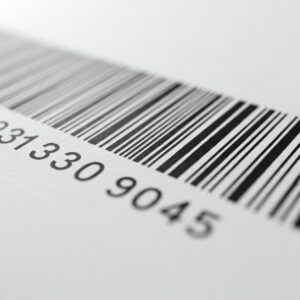Did you know that the barcode was first used on a pack of chewing gum?
Take a look at this fun fact about the origin of the barcode
We encounter them daily – those familiar black and white lines that streamline our shopping experiences. Barcodes are an undeniable part of modern commerce, but their origin story is surprisingly sweet. The very first item ever to be scanned using a barcode was none other than a humble pack of Wrigley’s chewing gum! Let’s peel back the layers of this fascinating historical tidbit and explore how this simple scan sparked a revolution in how we buy and sell.
The Genesis of the Barcode: From Idea to Implementation

The groundwork for barcode technology was laid much earlier than its widespread adoption. A patent for an initial barcode-like system was secured in 1952 by Norman Joseph Woodland and Bernard Silver, featuring a circular design. However, practical limitations in printing and scanning hindered its immediate success. The breakthrough came with the development of the linear Universal Product Code (UPC) in the early 1970s. This standardized format paved the way for its eventual integration into retail and beyond.
Wrigley’s Gum’s Pioneering Moment: A Scan Heard Around the World
The pivotal moment occurred on June 26, 1974, at a Marsh Supermarket nestled in Troy, Ohio. It was there that a simple pack of Wrigley’s Juicy Fruit chewing gum made history as the first product ever to be scanned using a UPC barcode. This seemingly insignificant transaction marked the dawn of a new era in retail efficiency and inventory management.
The Profound Impact: How Barcodes Reshaped Commerce

The introduction of barcodes triggered a significant transformation across the business and retail sectors:
- Accelerated Checkout Processes: Barcode scanners dramatically reduced the time spent at checkout counters, enhancing customer satisfaction and boosting retailer efficiency.
- Enhanced Inventory Accuracy: The ability to precisely track inventory using barcodes minimized errors, reduced waste, and optimized supply chain logistics for businesses of all sizes.
- Reliable Pricing Systems: Automated scanning ensured consistent and accurate pricing at the point of sale, eliminating manual errors and building consumer trust.
- Data-Driven Business Insights: Barcode systems provided a wealth of data on sales patterns and product performance, empowering businesses to make informed decisions regarding marketing and product strategies.
Barcodes Today: A Cornerstone of Modern Transactions
Despite the emergence of advanced technologies like RFID tags, barcodes remain a ubiquitous and cost-effective solution for product identification and tracking in a vast array of industries. From the grocery aisle to the logistics warehouse, barcodes continue to underpin countless transactions daily. The unassuming scan of a pack of chewing gum decades ago laid the foundation for the streamlined and data-rich commercial landscape we navigate today.

The story of the first barcode scan – a simple pack of Wrigley’s chewing gum – serves as a compelling reminder that even seemingly minor innovations can have a monumental impact. This unassuming technology has fundamentally reshaped how we buy and sell goods, leaving an indelible mark on the world of commerce. The next time you see a barcode, take a moment to appreciate its humble beginnings and the profound changes it has brought about.




